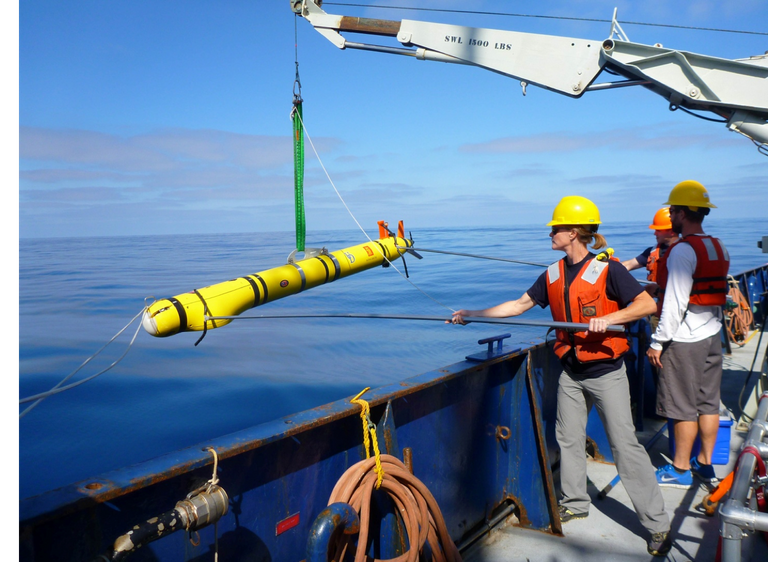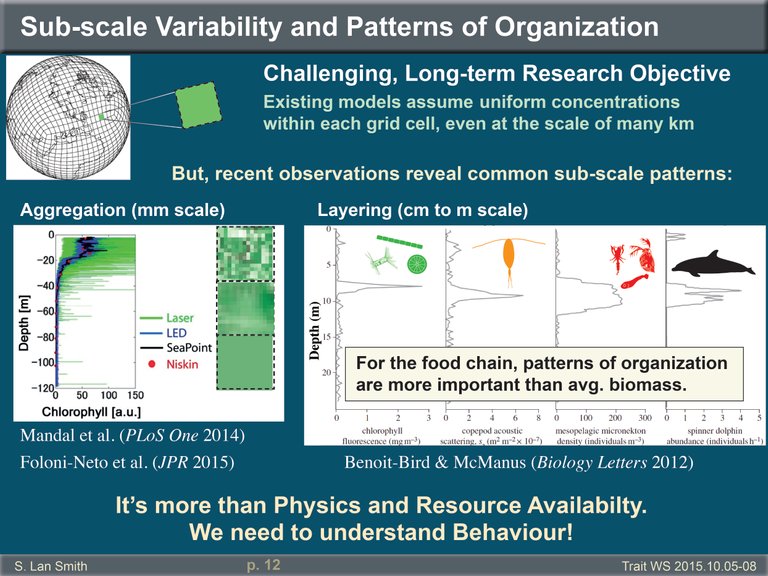Robots with sonar reveal many animals intricately coordinating their swimming behavior

Remote Environmental Monitoring UnitS REMUS are relatively low-cost Autonomous Underwater Vehicle (AUV). Here is one suspended from a crane aboard a research vessel. These vehicles allow researchers to observe marine organisms in their natural environment with high resolution in both space and time, providing data of unprecedented quantity and quality.
Kelly Benoit-Bird, currently based at the Monterey Bay Aquarium Research Institute, MBARI, uses acoustics to study how a variety of marine organisms, from plankton to dolphins, organize themselves in the ocean. She and her colleagues recently published new results in a paper entitled Prey in oceanic sound scattering layers organize to get a little help from their friends in the journal Limnology and Oceanography, one of the best journals for studies related to marine and freshwater ecosystems. At a conference a few years ago I attended one of her fascinating presentations, and I’ve followed her work ever since.
This press release, entitled Undersea robot reveals “schools” of animals in deep scattering layers gives more details for readers not so used to reading journal articles. Here I’ll summarize briefly and go on to some broader implications.
Why do all these animals coordinate their Behavior?

This is an updated version of a slide that I presented about two years ago at a workshop entitled Trait-based Approaches to Ocean Life. Most existing models of marine ecosystems either ignore behavior or represent it with very simplistic assumptions. Up until now it has been common to try to improve models by increasing the spatial resolution of their discrete grid cells, but I do not think this approach will suffice for representing the ecosystem dynamics, especially when the goal is to represent and understand biodiversity.
Although it has been known for decades that a variety of marine organisms form schools, swarms, and often layers in the ocean, the reasons for such behavior are not entirely clear. One reason, well known for years already for plankton, is that natural gradients in the availability of light (decreasing with depth) and nutrients (increasing with depth) make certain depth ranges optimal for growth. Other hypotheses have included predators concentrating in layers in order to better attack their layer-forming prey. The often observed vertical migration of zooplankton, for example, is thought to be largely driven by the need to avoid predators near the surface during daylight.
Fish, Squid, and even Plankton get by with a Little Help from Their Friends
These new observations reveal consistent patterns in the schooling of organisms. They tend to space themselves about one body length apart. So krill of course are more tightly packed than large fish or squid, but their spacing relative to their own body size is similar. The width of the schools tends to be about 100 individuals.
Kelly Benoit-Bird nicely presents this introduction to her research into how organisms organize themselves in the ocean. She is currently a MacArthur fellow, based at ]MBARI](www.mbari.org).
Dynamic behavior in response to a threat
This organization also changes dynamically, particularly when predators appear. Squid, for example, tighten up their spacing when dolphins come by looking to eat them. One hypothesis is that this may confuse the predators. Furthermore, organisms of other species adjust their swimming to close gaps created by this tightening up, even if the predator does not threaten them particularly. This reveals coordinated behavior between species of different sizes.
…and also by predators actively organizing their prey
One of Kelly’s interesting results, already revealed by studies several years ago, is that the patterns of organization of organisms are more important than the overall average biomass present, particularly for predator-prey interactions, which determine how energy flows within the food chain. Predators will even expend much effort, using valuable energy, to concentrate (aggregate) their prey, as Kelly details using dolphins as an example in the video below.
Spontaneous Order
To me, this is clear and detailed evidence of [Spontaneous Order]. No individual organism thinks this up, or designs this behavior. It’s the result of biological evolution, just as much cultural and economic organization results from the evolution of human culture. My previous post about the Parallels between Ecology and Economics includes an introduction to Spontaneous Order and Complexity].
What would the Plankton Politburo have to say about all this?
It’s really interesting that various species have evolved ways to successfully coordinate the behavior of many individuals, both with members of their own species and even with other very different species. As far as I know, they do this without writing any five-year plans, without appointing any Ministers of Motion, without electing senators or presidents, and without any kind of coercive hierarchy.
The people running governments invariably tell their subjects that it’s absolutely essential to organize humans into coercive hierarchies, so that some individuals wield power of the rest. That clearly serves their interests, by allowing them to live at others’ expense and even go so far as to order others around.
But why should the rest of us believe them!
Thanks to all who produced and made available the images used herein.
S. Lan Smith
Kamakura, Japan
July 12, 2017